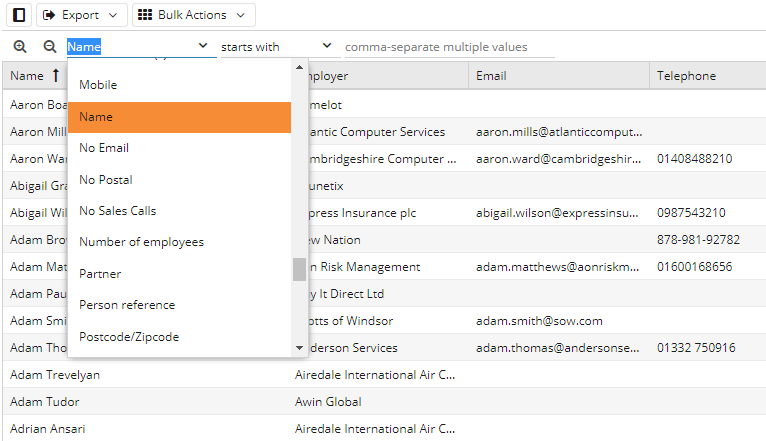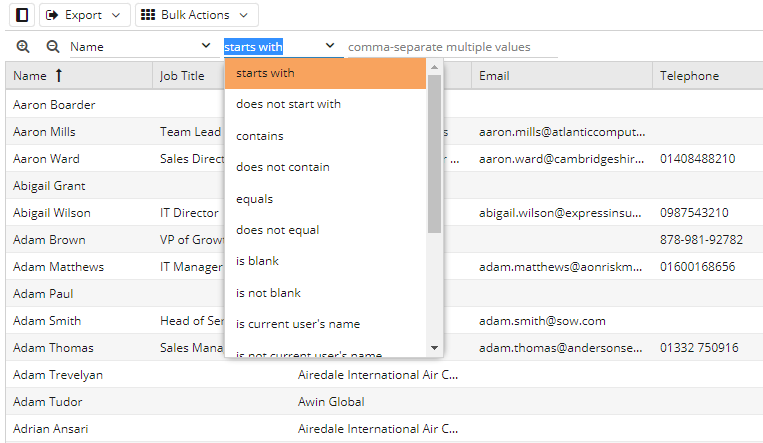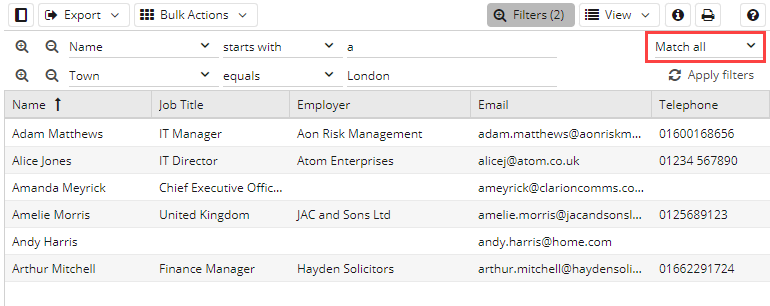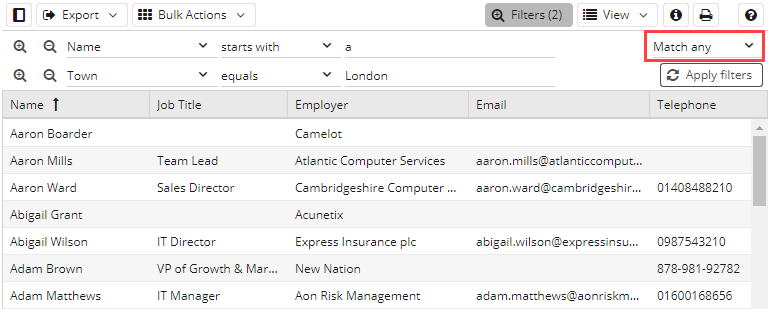- Welcome to the Knowledge Base
- Introduction
- Training
- Getting Started
- Preferences
- Activities
- Cases
- Forecasts & Quotas
- Importing Data
- Leads
-
Marketing
- Introduction to Marketing
- Marketing Campaigns
- Mailing Lists
- Products
- Mailshots
- Upload Library
- Templates
- Event Management
- Compliance Records
-
Spotler Integration
- What is Spotler?
- Navigating your Spotler homepage
- GatorMail
-
GatorLeads / Web Insights
- Tracking Code
- Setting up the Plugin
- Viewing Web Insights Data on your Form Layouts
- Domain Names and Online Activities
- Reporting incorrect Leads created through Web Insights
- Reporting on Web Insights data
- Using UTM Values
- Why aren’t Online Activities being created in the database?
- Why is GatorLeads recording online activities in a foreign language?
- GatorSurvey
- GatorWorkflow
- GatorPopup
- Opportunities
-
Integrations
- Mapping
- Electronic Signing Tools
- Creditsafe Integration
-
Zapier
- Introduction to Zapier
- Available Triggers and Actions
- Linking your Workbooks Account to Zapier
-
Setting up Zaps
- Posted Invoices to Xero Invoices
- Xero payments to Workbooks Tasks
- New Case to Google Drive folder
- New Case to Basecamp Project
- New Workbooks Case to JIRA Ticket
- Jira Issue to new Case
- 123FormBuilder Form Entry to Case
- Eventbrite Attendee to Sales Lead and Task
- Facebook Ad Leads to Sales Leads
- Wufoo Form Entry to Sales Lead
- Posted Credit Note to Task
- QuickBooks Online
- Survey Monkey responses to Tasks
- Multistep Zaps
-
Email Integrations
- Email Dropbox
- Workbooks Exchange Server Sync
- Workbooks Outlook Connector
- RevenueGrid Intelligence and Engage
-
Event & Webinar Integration Tools
- GoToWebinar
- ON24
- Microsoft Office
-
Outreach
- Installation
- Outreach Authentication
- Sync People to Outreach Prospects
- Sync Organisations to Outreach Accounts
- Sync Workbooks Opportunities to Outreach
- Sync Tasks/Activities from Workbooks to Outreach
- Sync Outreach Sequences to Workbooks
- Sync Outreach Sequence States to Workbooks
- Sync Outreach Sequence Step Numbers to Workbooks
- Sync Prospects/Accounts/Opportunities from Outreach to Workbooks
- Sync Outreach Tasks/Calls/Meetings to Workbooks
- Scribe/Workbooks Connector
- RingCentral
- Auditing
- Comments
- People & Organisations
- Projects
-
Reporting
- Introduction to Reporting
- Using Reports
- Charts
- Exporting Reports
- Advanced Reporting
- Report Snapshots
- Dashboards
-
Transaction Documents
-
Introduction to Transaction Documents
- Displaying & Adding Transaction Documents
- Copying Transaction Documents
- Transaction Documents Fields Help
- Transaction Documents Line Items Help
- Printing & Sending Transaction Documents
- Managing Transaction Document Currencies
- Managing Transaction Document Statuses
- Setting a Blank Default Currency on Transaction Documents
- Credit Notes
- Customer Orders
- Invoices
- Quotations
- Supplier Orders
- Contract Management
- Sagelink
-
Introduction to Transaction Documents
- Auditing
-
Configuration
- Introduction to System Administration
- Users & Security
- Preferences
- Database
- Accounting
- Email & Integration
-
Customisation
- Creating & Modifying Picklists
- Theme
-
Record Types
- Creating Custom Fields
- Report-based Custom Fields
- Linked Fields & Reference Fields
- Record Templates
- Form Layouts
- Customising relationships between parties
- Opportunity Stages
- Custom Records
- Automation
- PDF Configuration
- Contact Support
- Releases & Roadmap
Filtering
How to filter grids
To apply a filter click on the Filters button at the top right of the screen.
Activating filtering will turn on boxes which allow you to specify the parameters you wish to apply to the grid. The total number of filters applied is displayed in brackets beside the filter button. You are able to hide/show filters to give you more space within the Landing Page by clicking the filter button. Applying a filter is a four-step process:
Step 1: Choose the field on which you want to apply a filter using the drop-down menu on the first box.

Step 2: Specify the filter type from the drop-down on the second box.

NOTE:
- The filter type varies according to the type of data you're looking for. For example, if you're looking for a date, you'll be given the options of 'after', 'before', 'on', and 'not on' instead of the options shown above.
- There are a few dynamic filter types available. By selecting the filtering criteria of; is in calendar range, is not in calendar range, is in accounting period or is not in accounting period, it will be possible to create a dynamic view in which the Records presented may change to keep this information relevant to the current working day/month/period.

Step 3: Enter the criterion you're looking for in the third box.

Step 4: Click the Apply filters button. The screenshot above shows a custom view for People with a filter applied to limit the view to only those People whose name begins with C.
Adding Additional Filters
Once you've applied at least one filter you can add additional filters by clicking on the plus '+' symbol on the left. You can choose to apply all the filters concurrently (which will return records that fulfil all the criteria you've specified); alternatively, you can choose to apply the filters independently (which will return records that fulfil either the first criterion or the second criterion or the third criterion, and so on). This is controlled using the Match all filter conditions / Match any filter conditions drop-down menu on the right.
For example, the following two screenshots are based on the same People view as above. The first has a filter applied to limit the view to only those People whose name begins with A, which are based in London, so uses the Match all option.

The next screenshot shows the same filters but this time, the Match any option has been applied so now we can see People which begin with A or which are based in London, which is why the first entries visible aren't based in London.

If you want to apply more than one criterion to the same field (for example, you want to show the People whose names start with A or B or C, simply separate the criteria with commas).

You can apply as many filters as you like until you've identified the data you require.
Filters applied within Landing Page views can be saved and re-used later. To save a filter so that it remains in place every time you revisit the grid where you created it, click on the View button on the right and choose Save. When you next open this grid, the filtered view will be displayed and you can choose to leave it in place, modify it further (by applying further filter(s)), or reset the grid back to its original state (by clicking Reset).
Alternatively, you can save your filtered view and give it a name (this only applies to filters in Landing Page). To save and name a filter click on the View button on the right and choose Save as, which opens a dialogue box prompting you to enter and save a unique name for your filtered view. Any named views you've saved will appear in the left-hand column under My Views and clicking on these will activate the view.
Please use the following link if you would like to watch a video explaining 'Applying Filters and Saving Views': https://www.workbooks.com/resource-documents/applying-filters-and-saving-views/?portfolioCats=384
Related content

